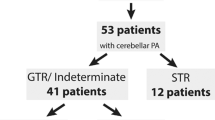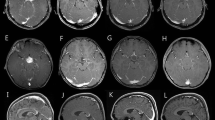Abstract
Proliferative activity of cerebellar juvenile pilocytic astrocytomas (CJPA) and its significance for prognosis was retrospectively investigated.
Forty-four consecutive children operated between 1981 and 1997 with a mean age of 8.3 years (3 months to 20 years) were reviewed. Clinical and radiological follow-up was available for 38 patients ranging from 0 to 18 yrs (mean 6.3 years). Proliferative activity was determined by MIB-1 immunohistochemistry on sections of resected tumor specimen.
Total resection was achieved in 35 children (79.5%), subtotal in 9 (20.5%). Currently, 31 are tumor-free, 6 have stable remnants, one developed spinal seeding and one died. Radiology revealed a cystic mural node type tumor in 27 patients (61.4%), a solid lesion with a small cyst in 5 patients (11.4%), and a solid tumor in 12 patients (27.3%). Mean MIB-1 labeling index (LI) of all tumors was 4.4% (range 0.6–12%, SD = 2.7) and did not correlate with age, gender, localization, amount of resection, follow-up status, histological appearence or grade of neovascularization, but showed a significant correlation to radiological types: 6.9% in solid tumors versus 3.7% in the cystic mural node type (p = 0.0037). Five year progression-free survival (PFS) of all patients was 84.4%, differences between subgroups of MIB-1<5% (27 patients, PFS = 87.4%) and MIB-1>5% (13 patients, PFS = 76.3%) were not significant.
CJPA showed a remarkable high MIB-1 LI, but no significant correlation to PFS in this series. Nevertheless, radiologically solid tumors demonstrated a significantly higher MIB-1 LI and thus may need further investigation for possible increased ability of regrowth.
Similar content being viewed by others
References
Dohrmann GJ, Farwell JR, Flannery JT: Astrocytomas in childhood: a population-based study. Surg Neurol 23: 64–68, 1985
Cochrane DD, Gustavsson B, Poskitt KP: The surgical and natural morbidity of aggressive resection for posterior fossa tumors in childhood. Pediatr Neurosurg 20: 19–29, 1994.
Abdollahzadeh M, Hoffmann HJ, Blazer SI: Benign cerebellar astrocytoma in childhood: experience at the Hospital for Sick Children 1980-1992. Childs Nerv Sys 10: 380–383, 1994
Garcia DM, Latifi HR, Simpson JR: Astrocytomas of the cerebellum in children. J Neurosurg 71: 661–664, 1989
Griffin TW, Beaufait D, Blasko JC: Cystic cerebellar astrocytomas in childhood. Cancer 44: 276–280, 1979
Ilgren EB, Stiller CA. Cerebellar astrocytomas. Part I. Macroscopic and microscopic features. Clin Neuropathol 6: 185–200, 1987
Schneider JH, Raffel C, McComb JG: Benign cerebellar astrocytomas of childhood. Neurosurgery 30: 58–62, 1992
Sgouros S, Fineron PW, Hockley AD: Cerebellar astrocytomas of childhood: long-term follow-up. Childs Nerv Sys 11: 89–96, 1995
Hayostek CJ, Shaw EG, Scheithauer B: Astrocytomas of the cerebellum. A comparative clinopathological study of pilocytic and diffuse astrocytomas. Cancer 72: 856–869, 1993
Rorke LB: Introductory survey of brain tumors. In: Cheek WR (ed) Pediatric Neurosurgery. Surgery of the Developing Nervous System. WB Saunders, Philadelphia, 1994, pp 351–355
Gjerris F, Klinken L: Long-term prognosis in children with benign cerebellar astrocytoma. J Neurosurg 49: 179–184, 1978
Kleihues P, Burger PC, Scheithauer BW: The new WHO classification of brain tumors. Brain Pathol 3: 255–268, 1993
Giannini C, Scheithauer BW, Burger PC: Cellular Proliferation in Pilocytic and Diffuse Astrocytomas. J Neuropathol Exp Neurol 58: 46–53, 1999
Kaplan EL, Meier P: Non-parametric estimation from incomplete observation. JAmStat Assoc 53: 457–481, 1958
Bucy PC, Thieman PW: Astrocytomas of the cerebellum. A study of a series of patients operated upon over 28 years ago. Arch Neurol 18: 14–19, 1968
Pencalet P, Maixner W, Saint-Rose C: Benign cerebellar astrocytomas in children. J Neurosurg 90: 265–273, 1999
Sutton L, Cnaan A, Klatt L: Postoperative surveillance imaging in children with cerebellar astrocytomas. J Neurosurg 84: 721–725, 1996
Clark GB, Henry JM, McKeever PE: Cerebral pilocytic astrocytoma. Cancer 56: 1128–1133, 1985
Daumas-Duport C, Scheithauer B, O'Fallon J: Grading of astrocytomas: A simple and reproducible method. Cancer 62: 2152–2165, 1988
Zülch KJ: Histological Typing of Tumors of the Central Nervous System. Geneva, World Health Organization, 1979
Krieger MD, Gonzalez-Gomez I, Levy ML: Recurrence patterns and anaplastic change in a long-term study of pilocytic astrocytomas. Pediatr Neurosurg 27: 1–11, 1997
Lapras C, Patet JD, Lapras C Jr, Mottolese C: Cerebellar astrocytomas in childhood. Childs Nerv Syst 2: 55–59, 1986
Kleihues P, Burger PC, Scheithauer BW: In: Histological Typing of Tumors of the Central Nervous System, 2nd edn. World Health Organization, Sobin LH (ed) Springer-Verlag, Berlin-Heidelberg-New York, 1993
Tomlison FH, Scheithauer BW, Hayosteck CJ: The signifi-cance of atypia and histologic malignancy in pilocytic astrocytoma of the cerebellum-A clino-pathologic and flow cytometric study. J Child Neurol 9: 301–310, 1994
Gerdes J, Lemke H, Baisch H: Cell cycle analysis of a cell proliferation-associated human nuclear antigen defined by the monoclonal antibody Ki-67. J Immunol 133: 1710–1715, 1984
Gerdes J, Schwab U, Lemke H: Production of a mouse monoclonal antibody reactive with a human nuclear antigen associated with cell proliferation. Int J Cancer 31: 13–20, 1983
Cattoretti G, Becker MHG, Key G: Monoclonal antibodies against recombinant parts of the Ki-67 antigen (MIB-1 and MIB-3) detect proliferating cells in microwave-processed formalin fixed paraffin sections. J Pathol 168: 357–363, 1992
Khoshyomn SH, Maier T, Morimura T, Kitz K, Budka H: Immunostaining for proliferating cell nuclear antigen: It's role in determination of proliferation in routinely processed human brain tumor specimen. Acta Neuropathol 86: 582–589, 1993
Morimura T, Kitz K, Budka H: In situ analysis of cell kinetics in human brain tumors: A comparative immunhistochemical study of S phase cells by a new in vitro bromodeoxyuridine-labeling technique, and of proliferating pool cells by monoclonal antibody Ki-67. Acta Neuropathol 77: 276–282, 1989
Sallinen PK, Haapasalo HK, Visakorpi T: Prognostication of astrocytoma patient survival by Ki-67 (MIB-1), PCNA, and S-phase fraction using archival paraffin-embedded samples. J Pathol 174: 275–282, 1994
Wakimoto H, Aoyagi M, Nakayama T: Prognostic signifi-cance of Ki-67 labeling indices obtained using MIB-1 monoclonal antibody in patients with supratentorial astrocytomas. Cancer 77: 373–380, 1996
Burger PC, Shibata T, Kleihues P: The use of the monoclonal antibody Ki-67 in the identification of proliferating cells: Application to surgical neuropathology. Am J Surg Pathol 10: 611–617, 1986
Louis DN, Edgerton S, Thora D: Proliferating cell nuclear antigen and Ki-67 immunohistochemistry in brain tumors: A comparative study. Acta Neuropathol 81: 675–679, 1991
Montine TJ, Vandersteenhoven JJ, Aguzzi: Prognostic significance of Ki-67 proliferation index in supratentorial fibrillary astrocytic neopasms. Neurosurgery 34: 674–679, 1994
Pollak IF, Campbell JW, Hamilton RL: Proliferation index as a predictor of prognosis in malignant gliomas of childhood. Cancer 79: 849–856, 1997
Czech T, Slavc I, Aichholzer M: Proliferation activity as measured by MIB-1 labeling index and long-term outcome of visual pathway astrocyatomas in children. J Neuro-Oncol 42: 143–150, 1999
Author information
Authors and Affiliations
Rights and permissions
About this article
Cite this article
Roessler, K., Bertalanffy, A., Jezan, H. et al. Proliferative Activity as Measured by MIB-1 Labeling Index and Long-term Outcome of Cerebellar Juvenile Pilocytic Astrocytomas. J Neurooncol 58, 141–146 (2002). https://doi.org/10.1023/A:1016053229688
Issue Date:
DOI: https://doi.org/10.1023/A:1016053229688




